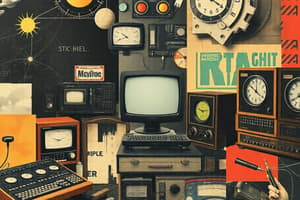Podcast
Questions and Answers
What is the primary function of an analogue to digital converter (ADC)?
What is the primary function of an analogue to digital converter (ADC)?
- To filter out noise from signals
- To amplify weak signals
- To convert analogue signals into digital signals (correct)
- To convert digital signals into analogue signals
What is the output of a digital to analogue converter (DAC)?
What is the output of a digital to analogue converter (DAC)?
- A digital signal
- A binary signal
- A pulse signal
- An analogue signal (correct)
What are binary variables typically represented by?
What are binary variables typically represented by?
- The digits 'true' and 'false'
- The digits 'yes' and 'no'
- The digits '0' and '1' (correct)
- The digits 'on' and 'off'
What is the state of the lamp when the switch is open?
What is the state of the lamp when the switch is open?
which of the following is combined two times to give a AND gate?
which of the following is combined two times to give a AND gate?
in electronics, the characteristic of an analogue quantity is that it...
in electronics, the characteristic of an analogue quantity is that it...
What type of quantities are processed in digital electronics?
What type of quantities are processed in digital electronics?
Which logic gate gives an output of '1' only when all of its inputs are '1'?
Which logic gate gives an output of '1' only when all of its inputs are '1'?
What is the purpose of a truth table in digital electronics?
What is the purpose of a truth table in digital electronics?
Which of the following is an example of an analog device?
Which of the following is an example of an analog device?
What is the function of a NOT gate in digital electronics?
What is the function of a NOT gate in digital electronics?
What is the main difference between analog and digital electronics?
What is the main difference between analog and digital electronics?
What type of propositions do Boolean algebra variables represent?
What type of propositions do Boolean algebra variables represent?
What are the two logic states represented in Boolean algebra?
What are the two logic states represented in Boolean algebra?
What is the output of a logic gate dependent on?
What is the output of a logic gate dependent on?
What is the result when S1 is open and S2 is closed in the AND operation?
What is the result when S1 is open and S2 is closed in the AND operation?
What can logic operations be thought of as?
What can logic operations be thought of as?
What is the systematic development of complex digital systems based on?
What is the systematic development of complex digital systems based on?
Flashcards are hidden until you start studying
Study Notes
- Analogue quantities, which are perceived by our senses, cannot be processed by digital circuits, so an analogue-to-digital converter (ADC) is used to convert them into digital signals.
- The ADC converts analogue signals into binary digits, which are then processed by a computer, producing a digital output.
- The digital output is then converted back into an analogue signal by a digital-to-analogue converter (DAC), allowing it to be perceived by humans.
- Electronic systems currently in use consist of both analogue and digital type circuits.
- A switch has only two possible states: open or closed, and binary variables can have only two possible states, represented by the digits '0' and '1'.
- Digital quantities are those that change in discrete steps, and electronic devices have become integral to daily life.
- Analogue electronics processes data in the form of analogue quantities, while digital electronics processes data in the form of digits.
- Logic gates are digital circuits that implement various logic operations, having one or more inputs but only one output.
- There are three basic logic gates: AND, OR, and NOT, and combinations of these gates include NAND and NOR gates.
- The AND gate gives an output of '1' only when all of its inputs are '1', the OR gate gives an output of '0' only when all of its inputs are '0', and the NOT gate gives an output that is opposite to the state of its input.
- Truth tables are used to display the values of inputs and outputs of logic gates.
- Boolean algebra handles variables that represent two types of logic propositions: 'true' and 'false', and operates with two logic states, '1' and '0', represented by two distinct voltage levels.
- Boolean algebra has become the cornerstone of digital electronics, allowing for the systematic development of complex digital systems.
Studying That Suits You
Use AI to generate personalized quizzes and flashcards to suit your learning preferences.




